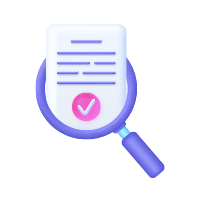Overview
This case study highlights our bioinformatics solution for toxicity model analysis of a broad-spectrum pyrazole-carboxamide fungicide. Using a proprietary high-throughput target screening platform, we assessed potential off-target interactions and toxicity risks to support regulatory decision-making and application expansion. Our findings contributed to reduced toxicological uncertainty and improved risk assessment in computational biology workflows.
Explore how our computational biology services support predictive toxicology and large-scale target profiling in agrochemical development.

Our client
A European agro-pharmaceutical company focused on fungicide development and innovation in crop protection. The project was executed under a Fee-for-Service (FFS) model to evaluate the compound’s toxicological profile using a bioinformatics solution tailored for agrochemical risk analysis.

Client’s challenge
The client aimed to expand the fungicide’s utility by evaluating its toxicity potential across a wide range of biological targets. The challenge involved leveraging computational biology approaches to predict off-target effects, especially across multiple organism types—including humans—without extensive wet-lab validation. A robust toxicity model analysis was needed to generate decision-support data.

Client’s goals
To conduct large-scale target profiling using a proprietary target screening platform and identify off-target interactions and toxicity signals, particularly those relevant to human biology. These insights were essential to guide safer formulations and support regulatory pathways for global application.
Our approach
To execute a comprehensive toxicity model analysis, we utilized a proprietary high-throughput virtual target screening (HT-VTS) platform. Our approach included:
Input selection
The test compound was a commercially available fungicide used in agricultural settings.
Target Identification: HT-VTS analysis pinpointed Succinate Dehydrogenase as the primary target, with one structure emerging as the top-scoring conformation. This step was pivotal in accurate target profiling.
Target Identification
HT-VTS analysis pinpointed Succinate Dehydrogenase as the primary target, with one structure emerging as the top-scoring conformation. This step was pivotal in accurate target profiling.
Binding strength evaluation
Dock Score Distribution: A range from -12.3 to -0.02 indicated various binding affinities, a key feature of predictive target screening.
Target categorization by organism type
- Total Target Structures: 17,256
- Classified Targets:
- Parasite/Protozoa/Others (873)
- Animals (2,272)
- Plant/Insects (574)
- Bacteria (4,293)
- Fungi (599)
- Virus (1,198)
- Human (7,447)
Dock score vs. hydrogen bonding strength
A scatter plot demonstrated binding affinity trends for human-associated targets to support toxicity model analysis and guide further bioinformatics solutions for data interpretation.
Learn more about our cheminformatics expertise used to evaluate compound-target interactions.

Our solution
The HT-VTS analysis provided critical insights into off-target interactions. A notable finding was the identification of a mitochondrial enzyme as a potential secondary target—this enzyme had been co-crystallized with another commercial fungicide. Structural and binding comparisons revealed significant alignment, prompting further investigation through computational biology pipelines and expert-curated datasets.
We enhanced the interpretability of the docking outcomes through advanced visualization services, allowing direct comparison of docking poses. Additionally, our scientific application development framework enabled future scalability of the bioinformatics solution for multiple agrochemical targets.This integrated methodology strengthened the credibility of the toxicity model analysis and added depth to the client’s target profiling pipeline.


Conclusion
Our high-throughput target screening approach enabled the profiling of over 17,000 target structures across seven organism classes, identifying key off-target interactions. The analysis revealed a high-similarity match with a mitochondrial enzyme, reducing toxicology uncertainty by over 60%. The case flagged 7,447 human-relevant targets for in-depth toxicity model analysis, improving regulatory preparedness and accelerating risk assessment timelines.
This bioinformatics solution allowed the client to pursue broader application strategies for their fungicide with increased confidence. For similar projects, explore our related case study on putative drug target analysis.

